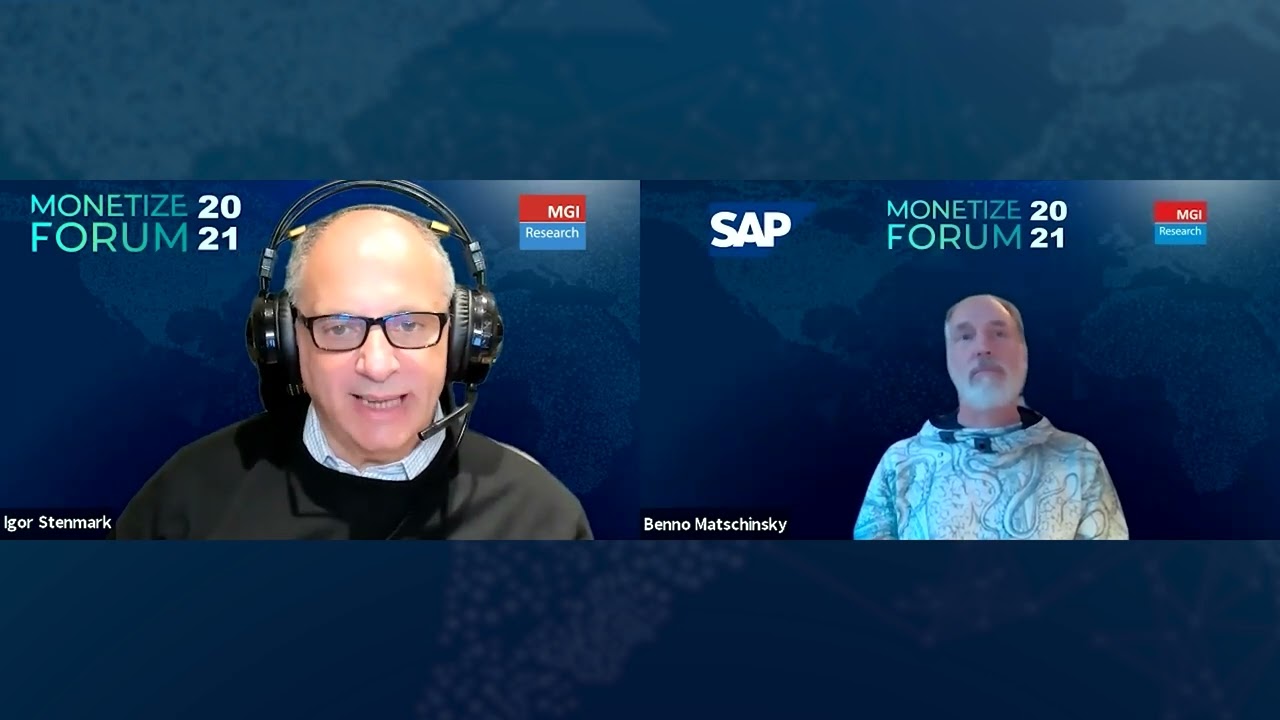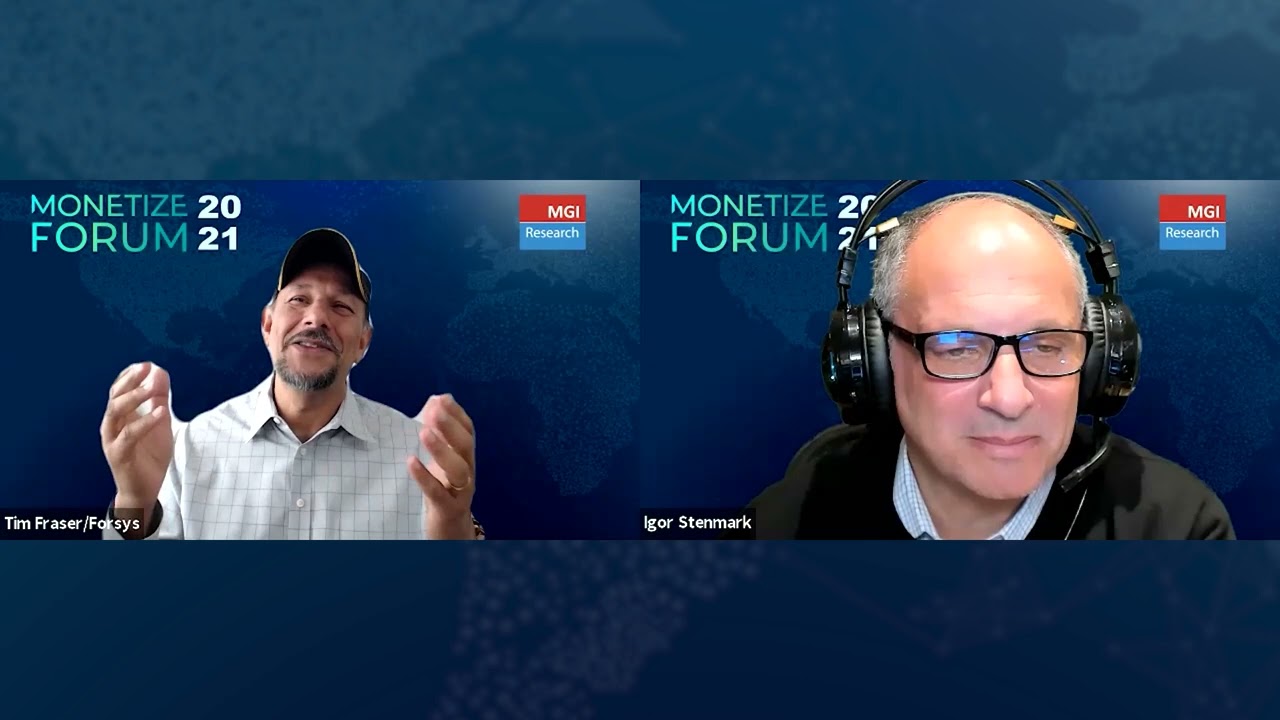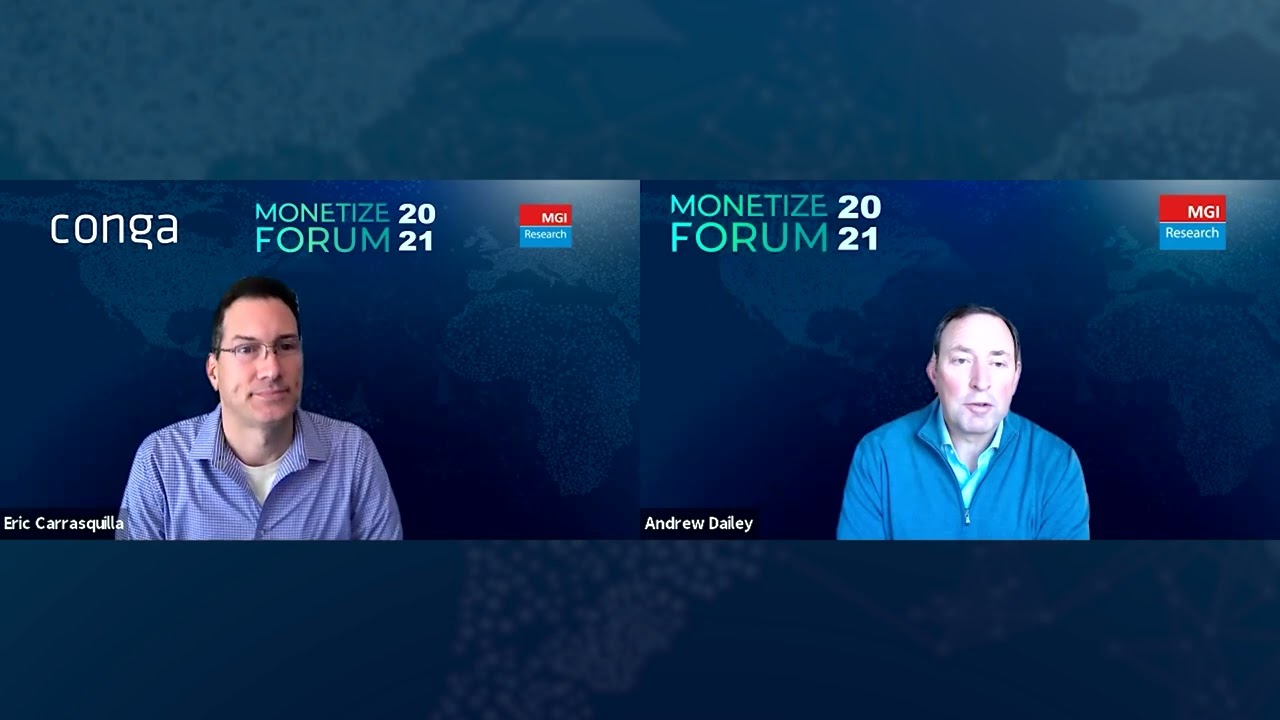There are companies in certain industries that have dealt with a high level of complexity for years, but for many others, this is an adjustment that they’re having to make now. With the tailwinds driving this uptick in complexity only gathering momentum, finding business solutions with the flexibility to scale is critical. Revenue solutions provider Conga is committed to helping businesses transform and automate their processes from end-to-end to reach peak performance in complex environments. MGI Research analyst Igor Stenmark spoke with Adam Breakey, Product Marketing Director at Conga, at the 2021 Monetize Forum to learn more about what constitutes high complexity and how Conga helps companies navigate that.
Key Issues
What defines a high-complexity use case?
What are the tailwinds driving the increased complexity we’re seeing?
What best practices are successful companies employing in dealing with high complexity?
Guest Profile
Adam is Product Marketing Director at Conga and responsible for the Configure, Price, Quote (CPQ) and Artificial Intelligence solutions.
Prior to Conga, Adam was a product marketer at LexisNexis, Progress Data, AICPA, and Lenovo. He is Pragmatic Marketing Certified and has spent the past 20 years working in product marketing leadership roles for enterprise and startup technology companies.
Igor Stenmark
Hello, this is Igor Stenmark of MGI Research, and we’re here at Monetize Forum 2021 online. Our next session deals with taming high complexity in quote-to-cash—really dealing with high complexity monetization scenarios. To illuminate this topic, we have a special guest today. We invited Mr. Adam Breakey of Conga to join us here and share his expertise and some of the deep knowledge that Conga has accumulated over the years in helping numerous companies address this issue.
Adam heads CPQ product marketing and AI at Conga. As I mentioned, he’s worked with numerous companies in this area, helping them deal with highly complex sets of requirements. He also has a deep background and expertise in product management and product marketing. Prior to Conga and Apttus, he’s been with companies including Progress Software and Lenovo. So, Adam, first of all, thank you very much for joining us here today.
Adam Breakey
Thank you.
Igor Stenmark
I really appreciate your time. Before we jump into the meat of our topic, could you maybe give us a bit of background on Conga? I’m sure many of our audience members know Apttus and Conga in different roles, and you guys have a pretty broad portfolio and a deep range of products in quote-to-cash, but really talk about the combined company and how you position your overall solution right now.
Adam Breakey
Absolutely, Igor. Thanks so much for inviting me here. I’m excited to talk about this topic. So, just this past summer, Apttus and Conga—two separate companies—became one and really set us up to be the leader in what we call digital transformation for business processes. I know that’s a lot of fluffy words, but the idea here is that we help our customers achieve peak performance whether that’s increasing revenue, managing their key relationships with their customers, or even overcoming complexity. We do that all with our comprehensive solution or suite of products that we built around these commercial operations. Our flagship products are configure, price, quote (CPQ) and contract lifecycle management (CLM). Then, we also have revenue management, digital commerce, eSignature, and other products that fill out that whole commercial operations suite.
Igor Stenmark
How would you define high complexity? We’re kind of framing our discussion around it, but how would a company know that they are a high-complexity case? They could be diving in and saying, “We want to go and re-implement billing, re-implement CPQ, transform our quote-to-cash,” all along not realizing that they’re dealing with a very high-complexity environment and that special care must be exercised.
Adam Breakey
Absolutely, great question. When we think about complexity here at Conga, specifically around our CPQ product, we think of about three different factors that contribute to complexity. The first is just the sheer number of items that the business sells. How many SKUs do you have on the shelf? Are you selling tens or maybe a hundred different products? That’s a pretty low-complexity requirement. Are you selling thousands, tens of thousands, or even millions of products? Obviously, the complexity grows as you add products, but that’s just one factor. Volume is one thing.
The second thing we look at is how complex those items might be to configure. An example of a basic configuration might be that I sell this widget off the shelf, it has no configuration, and you buy it and ship it out—a book would fall into that category. The other end of the spectrum, the highly complex, would be multiple layers of configuration that impact every other aspect of the configuration. An example I like to talk about here is buying a car. If you’ve gone on Tesla’s website, you pick a color, and it automatically suppresses interior colors that aren’t available for that exterior color you chose. The same would happen with performance modifications or luxury features you want to add to the car. Each of those things is adding to the complexity of the solution, and configuring a car is just a moderate level of complexity. You can get really complex situations where there are tens of thousands of different configuration options within a single solution that you’re trying to sell. If you take that number of configurations and multiply that by the number of SKUs, you see that you can quickly grow to a huge amount of complex data that has to be managed. And that’s only two of the three things that we consider when calculating the level of complexity.
The third one is around pricing. Does the organization that’s using the CPQ have basic pricing—essentially, one price per SKU? Maybe they have basic discounts like they offer 20% off at the holiday time. That would be a basic level of pricing. You can go to the other end of the spectrum where you have multiple currencies, layers of discounts, and configuration dependencies based on pricing. All of these things can add to the complexity. As you lay more and more of those pricing rules on top of each other, it just exponentially increases the level of complexity. So, if you think about it, when you multiply all those things together, somebody that has 1,000 SKUs can suddenly have an extremely complex need for a solution to solve that problem.
Igor Stenmark
On the consumer side, I can see how the drive towards better selection of products and more customization drives this growth in complexity. If you think more broadly towards B2B use cases, what are the tailwinds of complexity? What’s fueling this really rapid growth in complexity, and will we be able to handle it?
Adam Breakey
Yes, there are a few things that we see kind of pushing (the tailwinds, as you said) for complexity growing, and we see this growing and increasing in speed for the foreseeable future. We have customers like GE Healthcare, Thomson Reuters, and even Phillips who are dealing with millions of different price points and millions of attributes to manage; their complexity is already set. Those are companies that have been doing that for a long time, and they know and recognize their complexity.
But then, we talk to people like Salesforce, for instance. Salesforce says that their typical quote today is around 60 lines per quote. They expect that number to grow in the next couple of years to 250 lines per quote. So, what is Salesforce doing? They’re adding in bundles and options and all of these kinds of things that increase the number of lines on a quote, and, obviously, the number of lines on a quote is one of those impacting factors with regards to complexity.
The next tailwind we’re seeing is the drive towards bundling of products together. People are saying, “I can sell a low-margin item and sell a high-margin service with it.” By doing that bundle together, they’re increasing their overall margins. The more times you try to bundle a hard good with something else, the more complex it gets, especially when we’re talking about what we call solution selling. That’s combining physical hard goods (that widget on the shelf), professional services to install them, and then even subscriptions on top of that. An example here would maybe be a television streaming platform: you sell somebody a hard good, then you sell a subscription to that hard good (Hulu, Netflix, or Roku), then you sell professional services to install that at somebody’s home. That combination of different product types becomes quite difficult and quite complex for the CPQ platform to manage.
Igor Stenmark
So, let’s say I understand that I am a high-complexity use case. I have to really think through that, think through the dimensions—the fencing around it and whatever kind of risk factors I face in terms of complexity running away from me. If I’m trying to manage it, what does success look like? What should my metrics of measurement be? What are the best practices in this area? What are you seeing in your practice with customers—what are they doing?
Adam Breakey
So, there are a couple of things here that I’d like to touch on. Number one, when you’re dealing with the complexity that we’re talking about, we’re talking about quote-to-cash here. We’re not just talking about the quote side of things, we’re also factoring in the cash side of things where something goes to contract and you manage that through the CLM. Conga has what we call the single data model where everything runs on the same data model. That enables somebody that adds a subscription or a service to the quote to automatically add the legal language attached to that offering into the contract. So, being able to successfully tie those two things together is something that Conga is quite adept at, and we’re able to do that really well for many of our customers.
Then, what are they looking at as far as the success metrics? What are they looking to see as a return on the investment? There are a couple of things that we look at. We have customers that are reporting that they’re seeing increased margins—27% increased margins—thanks to being able to bundle high-margin offerings, such as those professional services I’ve talked about, with the low-margin hard goods. So, being able to bundle and create complete and accurate configurations and quotes is increasing people’s margins.
Another thing that we look at is what the win rate is. Are we seeing an increase in win rates on the deals because of our solution? The answer to that is absolutely yes. We highlighted that idea about the streaming service with the subscription and all that together. Normally, if you’re not using Conga CPQ, that’s three separate contracts or quotes that need to be approved: one for the hard good, one for your subscription, and one for professional services. With our solution, we send out a single piece of paper with one signature line. What that means is you’re able to respond to the quote request faster, and your salespeople don’t have to chase down multiple contracts and multiple pieces of paper as they attempt to close the deal. And, at the end of the day, their win rates are going up because they look more responsive and more put together, if you will.
Igor Stenmark
When you look at the broad spectrum of customers you guys have, what are some of the best practices you’ve seen out there? What are some examples of really ingenious approaches to this area? As people managing high complexity, where do you think the innovation and disruptions are going to come from in this area?
Adam Breakey
When we’re talking about the current customers, what they’re doing, and who’s really successful, the names I mentioned before all fit that criteria. We have a very popular medical technology company that has millions of different price attributes and line items within their CPQ platform, and being able to manage that within CPQ is something that they couldn’t do outside of the Conga CPQ application. We’re able to break down the barriers of complexity in ways that other people have not been able to.
In looking at possible disruption and innovation that’s coming down the road in the quote-to-cash space, it’s easy to say that AI and augmented reality—being able to look at products in three-dimensions, pricing guidance, and all that kind of machine learning—is likely where the most disruption and innovation is going to be coming from.
Igor Stenmark
Okay. Just to follow up on this last question, do you have a prediction for 2021, anything you think is interesting that’s going to happen in this space specifically, or even more broadly? Feel free.
Adam Breakey
Sure, I think that the number one thing is the momentum’s already there, so we just expect it to continue to exponentially grow regarding the level of complexity of the quotes that are being generated, not just within our system, but across the board in the industry. It’s just the way the winds are going. We really have seen that trend take hold, and we expect it to continue to accelerate.
Igor Stenmark
Great. Is there one aspect of Conga that every C-level or senior business finance technology person should know about but doesn’t already? What’s the biggest secret of Conga?
Adam Breakey
The biggest secret of Conga? I think what I would like any C-suite decision-maker to look at is how the analysts cover Conga. We are seen favorably by Gartner, IDC, Nucleus, Forrester, et cetera. Many, many, many analysts cover our space, and they all put us up there in the leadership position. The only companies in the leadership position are either those that have CRM and ERP audiences and attach CPQ to it and then us, where we lead with CPQ and CRM. That makes us unique in the industry.
Igor Stenmark
Adam, thank you very much for joining us today and sharing your expertise in this area. I hope you have a great remainder of Monetize Forum 2021, and I would encourage everybody to go visit the Conga booth in the exhibits area to continue networking. Thank you very much.
Adam Breakey
Awesome. Thank you.




